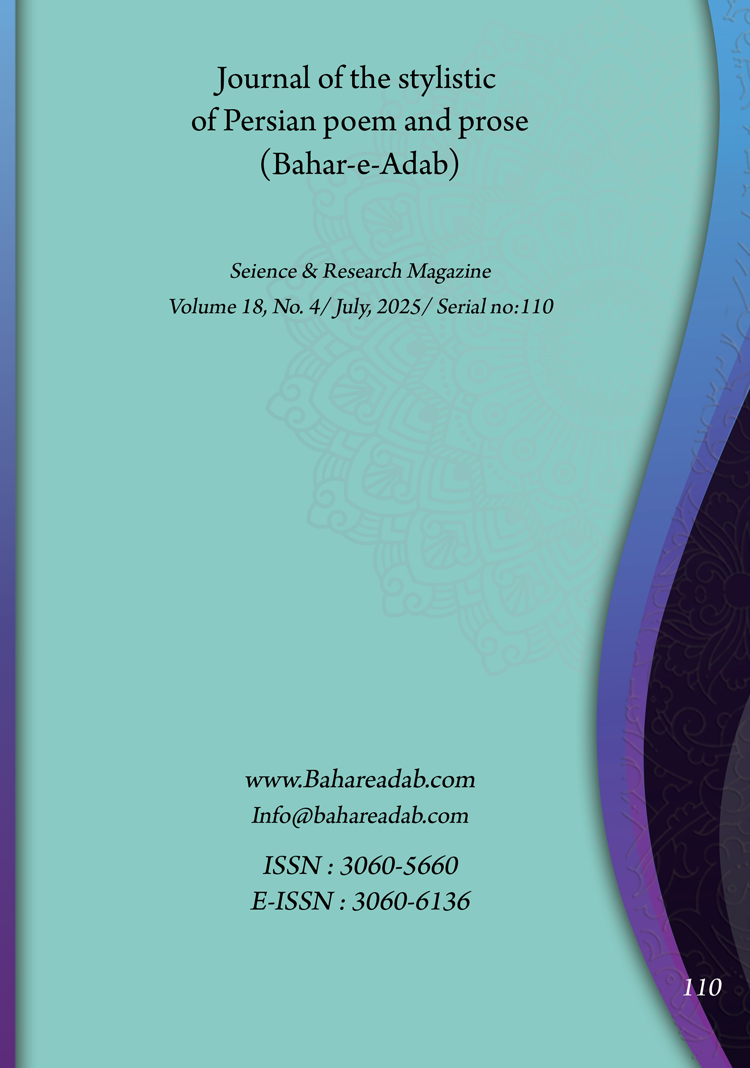- Count View : 48
- آدرس کوتاه شده مقاله: https://bahareadab.com/article_id/1836
- کد doi مقاله: Doi: 10.22034/bahareadab.2025 .18 .7839
Journal of the stylistic of Persian poem and prose
volume Number 18،
number In Volume 4،
،
issue Number 110
A comparative study of the description of stone types in the Damascus Nakhb-e-Duhr and the Hamadani Ajaib-nameh with two gemology books (Tansukh-nameh and Arays-al-Jawaher).
Parvin Abyazi Esfahlan (Author in Charge), Ahmad Mohammadi
Abstract
BACKGROUND AND OBJECTIVES: In this article, a comparative study of the types of stones in two works (Nakhbah-e-Dahr) by Damascus and (Ajaib-e-Nameh) by Hamedani, with two books on gemology titled (Tansukh-e-Ilkhani) by Khwaja Nasir al-Din Tusi and (Arays al-Jawahir) by Abul-Qasim Abdullah Kashani, has been conducted. The aim of paying attention to this issue is to express the commonalities in the content of the aforementioned books regarding the quality, properties, and wonders related to minerals and stones of Crimea. The authors of this article have also paid attention to the issues of disagreement between the authors of the aforementioned books in this regard.
METHODOLOGY: The present research is a theoretical study conducted using a library method and a descriptive-analytical method. The scope and population of the study are the four books mentioned in the title of the article.
FINDINGS: Many books have been written over the years about stones and minerals and their related properties and wonders, most of which date back to the Islamic centuries. All four books reviewed in this article are notable works, part of which is dedicated to discussing the properties of stones, their types, and the folk beliefs associated with them.
CONCLUSION: The results of the research indicate that many properties have been attributed in great detail to the various stones mentioned in these four works, sometimes with a touch of exaggeration and imagination. In terms of the apparent structure, the Damascene method of describing the types of stones - despite the strictness and difficulty of the language - is closer to the method of gemological books. Also, in the Hamedani Ajaibnameh, in addition to the usual descriptions of stones, gems and their magical conditions and properties are also mentioned.
Keyword
Nakhb-e-Dahr-e-Damasci
, Hamadani Ajaib-nameh
, Ilkhani's Tansukh-nameh
, Arays-al-Jawahir Abdullah Kashani
, Comparative Study
- -Istakhri, Abu Ishaq Ibrahim (1961), Masalak va Mamalak (Persian translation of the fifth century/sixth AH), edited by Iraj Afshar, first edition, Tehran: Translation and Publishing House.
- -Ansari Dimashqi, Shams al-Din Mohammad ibn Abi Taleb (1978), Nakhbeh al-Dharfi Ajayib al-Barbu al-Bahr, translated by Seyyed Hamid Tabibiyan, Foundation of Iranian Academies, Iranian Academy of Arts and Sciences.
- Barati, Parviz (2008), Narration, Form and Structure of Ajayib-e-Namaha, Tehran: Nashrafkar.
- Khakzad, Ahmad, Radour Zanganeh, Mehri (2002) Introduction to Mineralogy in Iran, Tehran: Shahid Beheshti University Printing and Publishing Center.
- Tabari, Mohammad Ibn Ayub Al-Hasab (2012), Tuhfat-ul-Gharayib, edited by Jalal Matini, second edition, Tehran: Library of the Museum and Documentation Center of the Islamic Consultative Assembly.
- Tusi, Mohammad Ibn Hassan Tusi "Khawaja Nasir al-Din Tusi" (1984), Ilkhani Tansukhnameh, with an introduction and annotations by Seyyed Mohammad Taqi Modarres Razavi, second edition, Information Publications.
- Kashani, Abu al-Qasim Abdullah (1966), Arays al-Jawaheru Nafais al-Atayeb, edited by Iraj Afshar, Tehran: National Art Association Publication Series.
- Unknown author (2009), Jawharnameh, (Abbreviation of Ilkhani Tansukhnameh of Khawaja Nasir al-Din Tusi), edited by Yousef Beg Babapour, first edition, Qom: Islamic Reserves Association.
- -Hamadani, Mohammad Ibn Mahmoud (2011), Ajaibnameh [Ajaib-ul-Muhlaqat and Gharayib-ul-Mujoudat], Text edited by Jafar Madras Sadeghi, First edition, Tehran: Nashrmarkez.
- b) Articles
- -Abyazi, Parvin, Mohammadi, Ahmad (2010), Study and comparison of common themes in Tohfat-ul-Gharayib of Tabari and Ajaibnameh of Hamadani, Specialized Monthly Journal of Persian Poetry and Prose Stylistics (Baharadab), Year 13, Issue 9, Serial Number 55, pp. 307-285.
- -Bagheri Khalili, Ali Akbar (2003), Folk Medical Beliefs in a Fragment of Literary Texts, Journal of Humanities and Social Sciences, Year 4, Issue 14, pp. 39-13.
- -Panahi, Wajiheh (Bita), Recognition of the Holy Stones (In the Literary Texts of the 8th Century), Journal of Culture and Literature, pp. 45-86.
- -Jahanshahi Afshar, Ali (2016), Therapeutic Properties of Precious Stones in Ancient Medical and Literary Texts, Journal of Traditional Medicine of Islam and Iran, Year 7, Issue 3, pp. 315-307.
- -Zabihi, Rahman, Kasaei, Maryam (2017), Therapeutic Properties of Stones in Ancient Mineralogical Texts, Bimonthly Journal of Culture and Popular Literature, Year 9, Issue 42, pp. 280-255.
- -Zamardi, Humaira, Mehri, Fatemeh (2014), Ajaibnameh and Ajaibnameh Texts, Structural Introduction of the Texts, Baharadab Specialized Quarterly, Year 7, Issue 4, Serial Number 26, pp. 354-339.
- -Sam Khanyani, Masoumeh, Akhiani, Jamila (2023), Manifestations of the knowledge of "properties of elements" in Persian mythological and allegorical stories (based on Nuzhat-nameh Ala'i, Aja'ib-ul-Mukhluqat, Jawaher-nameh and Al-Abniyyah 'an-Haqa'id al-Adawiyah), Persian Literature Textual Studies Journal, Volume 15, Issue 2.
- -Moharmi, Arghawan (2018), Study of precious stones in the book "Aja'ib-ul-Mukhluqat and Gharayib-ul-Mujudah", Zakaria Qazvini, Faranma Magazine, Year 2, Issue 4, pp. 68-79.

